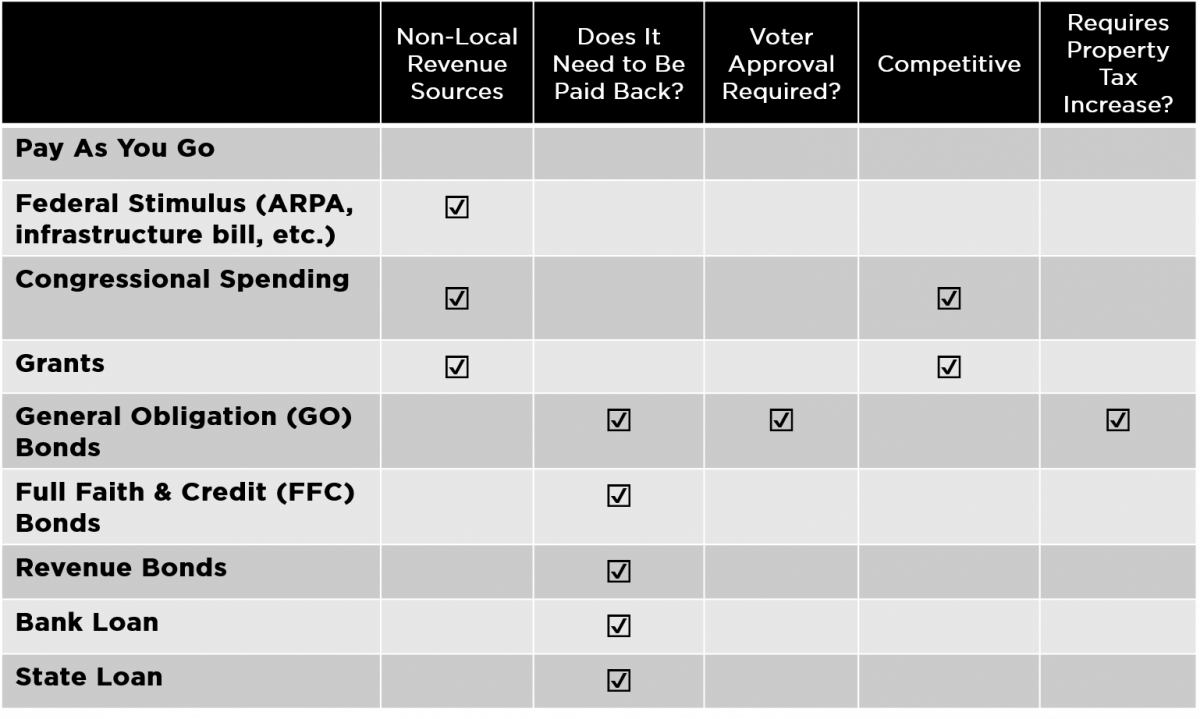Exploring Options for Facility Funding

In the first half of 2022, the City Council and staff reviewed the best way to fund the necessary work on City facilities to remedy the significant shortcomings identified in the Facilities Needs Assessment Project.
The investigation began with an understanding of the array of funding sources available to pay for municipal building or facility projects. These fall into three broad categories and are explained in detail on this page.
- Current revenues - Examples include reserving funds from existing resources and reducing other services to redirect revenue.
- New revenues - Examples include federal stimulus, congressionally directed spending, and grants.
- Debt - Examples include loans, revenue bonds, or general obligation bond.
Current Revenues
This category does not seek additional funding from outside the City’s resources. One way to do this is by reducing City services and using that money to pay for building projects. Another way is through the use of reserves that were set aside over time for the express purpose of funding building projects. This method, known as ‘Pay As You Go’, works best when adequate planning and fiscal discipline has taken place to identify what is needed before it is needed. This has not been the case in Corvallis for more than 50 years. In addition, Pay-As-You-Go puts the burden for paying for projects on existing residents, despite the fact that future users will benefit from the projects.
New Revenues
This category use money from outside the City that does not have to be paid back, instead of incurring debt or increasing taxes or fees. Federal stimulus monies, like those made available through the 2021 American Rescue Plan Act (ARPA), are a great example. These funds are ideal for one-time costs like capital projects. In fact, the City has already taken advantage of the opportunity to use stimulus funding to tackle two of the building projects and to get a start on a third. Other examples of new revenues include Congressionally directed spending that can provide a specific amount of federal discretionary funding for a specific purpose. Government grants to fund components of a project, such as energy efficiency or disaster resiliency improvements.
Debt
This category uses money borrowed from outside entities that must be paid back, with interest, like a bank loan. Using debt to fund large capital projects is a common practice in local government. Bonds are the most common debt option used by cities like Corvallis. In this method, the City would borrow money from the market, then pay back the bond, with interest, usually over 20 or 30 years. Specific types of bonds include:
- Revenue bonds - Repaid from dedicated revenues such as user charges, and not from taxes
- Full faith and credit (FFC) bonds - Repaid from any available City resources, including taxes
- General obligation (GO) bonds - Repaid by an additional property tax levied for that specific purpose. GO bonds require approval from Corvallis voters.
Finding A Formula That Fits
After understanding what was available, Council and staff moved to looking into the best ways to use these sources alone or in combination to come up with reasonable and achievable funding strategies for individual projects.
A starting place was to first seek to use funding from sources outside the City to the greatest extent possible (i.e., federal stimulus) to ease the burden on local residents. Maximizing outside funding sources responds to legitimate community concerns about the impacts of facility funding on tax and fee rates. After we've gotten the most from non-local sources of revenue, the next move is to leverage all the debt options that do not require a new dedicated property tax (i.e., FFC bonds and loans). After that, we can explore using GO bonds to fill any remaining funding gaps. In general, combining multiple funding sources for a project or group of projects is a successful strategy.
When looking at debt options, grouping projects into ‘packages’ has advantages. For example, there are various professional services required to issue a bond. By aggregating projects into one comprehensive bond strategy, it is possible to eliminate duplicated fees associated with multiple rounds of bonding. Using this strategic approach could potentially save hundreds of thousands of dollars in fees and limit the City’s exposure to market driven interest rate changes as well as fluctuations in investor demand; both of which are outside of the City’s control and influence.
Another strategy is to stagger the timing of when projects move forward, so the need for funds is spread over time, smoothing out the impact. Several of the projects identified in the Citywide Facilities Strategy are dependent on other activities. These projects cannot move ahead until those other work efforts are completed. As a result, taking these projects out of consideration for development of funding strategies (for now) is a prudent move.
Using a strategic approach, the 11 projects recommended in the assessment work were whittled down to a much shorter list of 6 projects that need some combination of funding support to move forward.
(Go back: Investing in Corvallis Facility Needs)
| Mark Shepard | City Manager | 541-766-6418 | city.manager@corvallisoregon.gov |